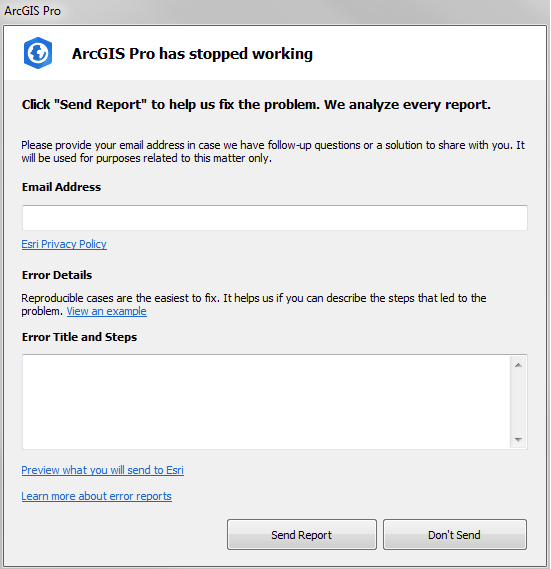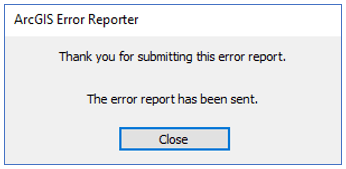Written by Kory Kramer, Customer Advocacy Lead – Desktop
The upcoming releases of ArcGIS Pro 2.3 and ArcMap 10.7 come equipped with a revamped error reporter, and the team here wanted to give you a sneak peek and talk a bit about the improvements. (As I wrote that sentence I thought, heck, I hope this is the only time you ever see this dialog box! This is one of those weird announcements where we want to tell you about a new feature we hope you never see.) Our teams were motivated to improve this experience by customer input about the error reporting process.
First things first – what is an error report? When ArcMap or ArcGIS Pro crashes, a dump file (.dmp) is created that contains information about the code that caused the failure. That .dmp is a big piece of what we refer to as the error report, but there are other very important parts that you can include like your Email Address and an Error Title and Steps. When the application stops working, you’ll be presented with the error reporter dialog box:

1. We analyze every report
A consistent complaint we hear from our customers is that you don’t even know if anybody looks at these things. So why send them anyway!? Every report is analyzed, so we wanted to assure you of that by saying “WE ANALYZE EVERY REPORT.” Period. Note that analyzing every report does not guarantee that we will be able to fix the problem. Keep reading to help us increase the probability of isolating the problem and fixing it.
2. Email Address
While it is optional, it is highly recommended that you include your email address. This opens up a couple of possibilities. Once in a while, we need some more information. A good way for us to get more information is to reach out to somebody who experienced the crash to see if they’re able to share more details, and the only way for us to do this is through a valid email address.
The other thing that can happen when you provide a valid email address, and we have a high-confidence fix for the crash (either in a patch or a more recent release), is that we’ll contact you with information about the fix. See how that works!? As somebody who really, REALLY loves our customers and wants to help you, it is painful to have a fix in hand and not be able to give it to you. In fact, I’ve been known to make general announcements when this has happened in the past.
Why did I write “valid email address” above? Twice! Well, I recently sent an email out to a list of customers to let them know about a crash that was fixed. They just needed to install the patch. One of the customers on the list was Donald.Trump@gmail.com. Shortly after sending that email, I got a failure to deliver message for that address. Frustrating – we weren’t able to help, and that user may still be out there experiencing a crash.
Just this morning I got an email from a developer trying to fix an issue reported through the error reporter, “This user left a comment, but the comment is inconsistent with the crash dump. An e-mail address would be way more useful.” So please, help us help you and include a valid email address.
3. Error Details
In this section we’re asking for you to describe the steps that led to the problem. The bottom line is that reproducible cases are the easiest to fix. The more detail, the better; but saying that, we completely get it that you might not remember exactly what you were doing that led up to a crash. Just try your best as it might provide the missing piece to the puzzle!
Click the View an example link to see the type of description that is helpful for engineers and developers to reproduce and fix an issue.

Finally, when you click the Send Report button, instead of the dialog disappearing with no indication that anything happened, you will now get a progress indicator followed by a confirmation that the report was sent.

So what do error reports have to do with manners?
- If you ever have to send one of these to us, we’re sorry that it happened. Seriously.
- Please include your email address.
- Please include details.
- Thank you for submitting error reports so that we can provide fixes.
You can find out more about Esri’s Privacy Policy through the link in the report dialog.
You can also learn more about error reports from the report dialog.
Commenting is not enabled for this article.